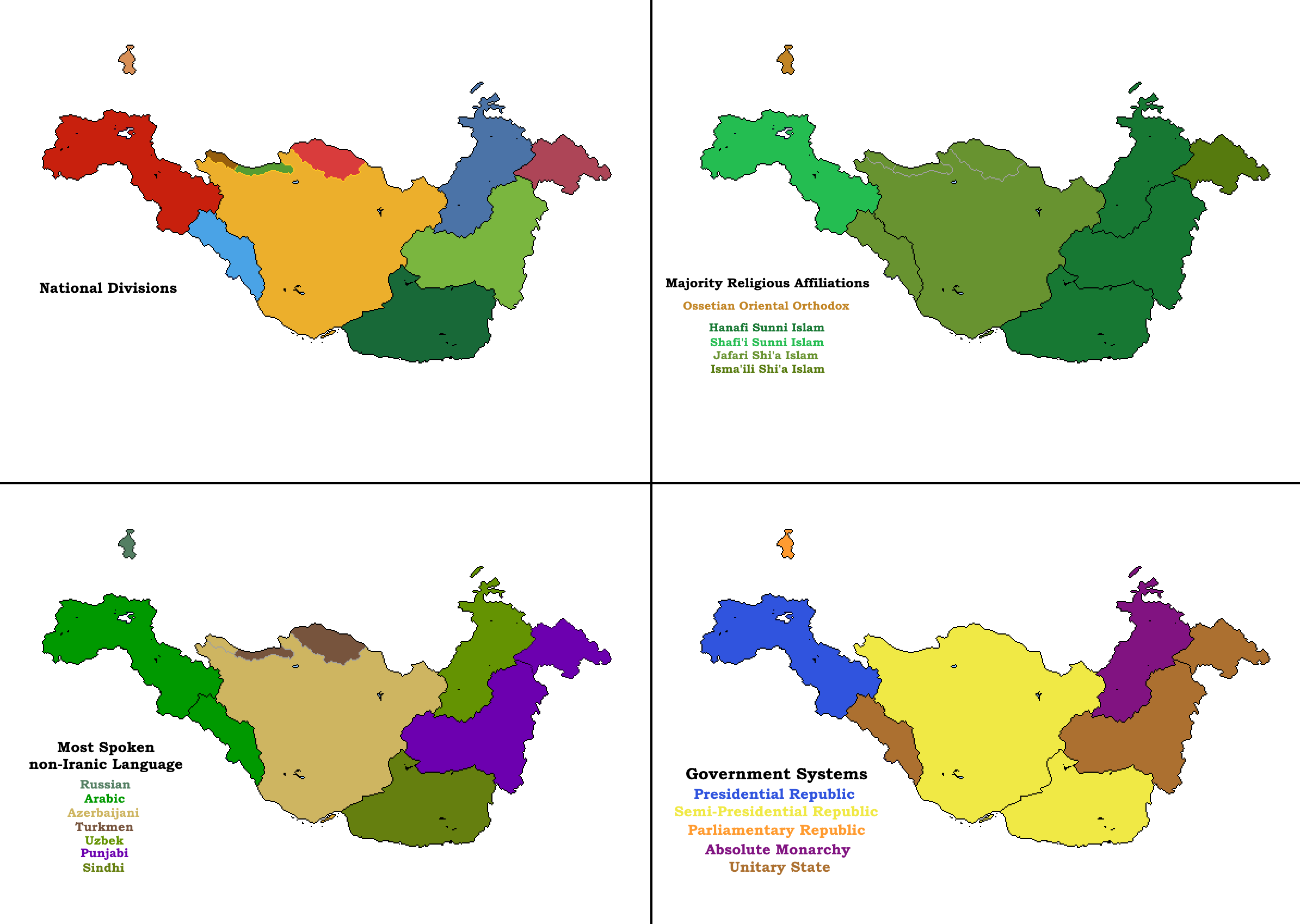HOME | DD
 Peter-MacPherson — AWP | Four Ways to Divide the League of Zerand
Peter-MacPherson — AWP | Four Ways to Divide the League of Zerand

#afghanistan #alternatehistory #alternatereality #armenia #azerbaijan #baloch #balochistan #caucasus #future #iran #islam #kurdistan #kurds #map #ossetia #pakistan #pashtun #persia #indoeuropean #pashto #alternatefuture #flagsandmaps #alternatehistorymap
Published: 2024-04-07 00:15:56 +0000 UTC; Views: 5534; Favourites: 26; Downloads: 2
Redirect to original
Description
the League of Zerand is a formal military and economic compact formulated by a council of regional leaders in the Middle East, under a common nationalistic identity as Iranic peoples and (until the controversial but ultimately crucial inclusion of Ossetia) the practice of Islam. The League of Zerand would come to position themselves as allies of the European Union, the latter of which had been very militaristically active in Europe and the Balkans during the 2040s. This alliance was first a part of the Kars Crusade, which saw an alliance of NATO, the United Caucasus, and the League of Zerand against the radical government of Turkey, which had previously participated in the Third Balkan War and refused to recognize the Treaty of Pescara, and had alongside Azerbaijan begun to invade Armenia, Georgia, Dagestan, Bulgaria and Greece. Ossetia would serve as the meeting place for diplomatic hearings between Zerand and EU factions. Turkey ended up humiliated by the end of the Third Balkan War and Kars Crusade, and the justice for the Armenians in reclaiming their stolen land had rallied the vast majority of individuals from the allied factions to the cause of humiliating Turkey.the League of Zerand would see a massive boom in military and economic might and influence going into the 2080s, and with the collapse of Islamic Theocracy in Iran in the 2030s the attention of the new nation began to turn toward Afghanistan. Tajikistan had come under the rule of a military dictator who had engaged in a blitzkrieg into Kabul, destabilizing the region once again after the brief recovery within the Islamic Republic of Afghanistan from 2020 to 2076. Iran would assist in the alliance along with Pakistan, and the region was eventually divided along ethno-religious lines. Tajikistan to this day continues to struggle putting down Shi'a Hazara rebels in central Afghanistan. While the Sunni Aimaq Persians were initially less keen on union with Persia, the secular and democratic system eventually convinced the regional leaders to lay down their arms. Due to the civil conflict in Tajikistan after the division of Afghanistan, the great military leader Aslonbek Niyaz, conqueror of Kabul, ender of the Grave of Empires, had gained a sort of stardom within his nation and beyond it. He had become considered the "Napoleon Bonaparte of the Persians" after the comparison was drawn by news outlets in Kazakhstan. He declared an era of great economic reform, working closely with the League of Zerand before eventually joining them in 2091. He made peace with the Hazara resistance and dissolved them, assuring that they would have religious freedom. He later, however, declared himself an Emperor, rather than military dictator, and thus transitioned Tajikistan into an era of monarchy. Turkophobia runs rampant in Tajikistan at the turn of the century, and Uzbekistan is eyeing their close neighbor very anxiously as the decade nears it's end. Even Persia is anxious, as the absolute monarchy of the Tajiks and their emperor, a Napoleon-analogue according to much of Asia's media outlets, is looking pretty damnable by the European Union's standards. Democracy and civil liberties is the end goal of Persia, which stands as of yet as the primary leader of the League of Zerand. Ossetia is also a largely democratic nation, serving as the beacon of civility and safety between Europe, Caucasus, and Persia, being a part of all three major alliances in the area.
Pakistan, which although an ally of the Zerand League was not itself a part of said league, fell apart due to inner ethnic conflicts shortly after 2103. Balochistan and Pashtunistan would come to join the League of Zerand shortly afterwards, and the Pamiri Republic would be formed out of territory that Tajikistan had annexed as part of 'peace-bringing efforts' and 'military intervention' into the Kashmir region. Pamir would join the League of Zerand as a puppet state. Thus, bringing the total number of national members within the league up to 8 from it's previous 5.
In 2110 the League of Zerand continues to stand as a major force on the world stage, especially given how fractured the majority of the Arab World has become politically, the importance as the major economic center of the Islamic world is quickly shifting towards Iran. The attempts of the Federation of Arab States in what was once former Saudi Arabia, in it's capital of Madinah, has definitely worked toward uniting all of the Arab Peninsula, but as of yet the major political and societal differences in every region; Yemen being controlled by Zaidi Islamists, Oman being controlled by Ibadi Islamists, the Hashemites control much of the southern levant and the northwestern Arab peninsula, North Levant being a secular state with a very ethnically mixed population not singularly connected to an overall 'Arab' identity, and Egypt is currently controlled by major unitary party and has a massive rogue faction in Darfur that said dictatorship willingly turns a blind eye to. Nevermind whatever Fezzan and Hassiniya are doing, now that pan-Berber nationalists have taken over Tunisia, Algeria and Morocco and purged all the Arabs in the area, forcing them all into neighboring communities. Arabia is far too busy to do anything about Zerand continuing to elevate their power and influence.

























